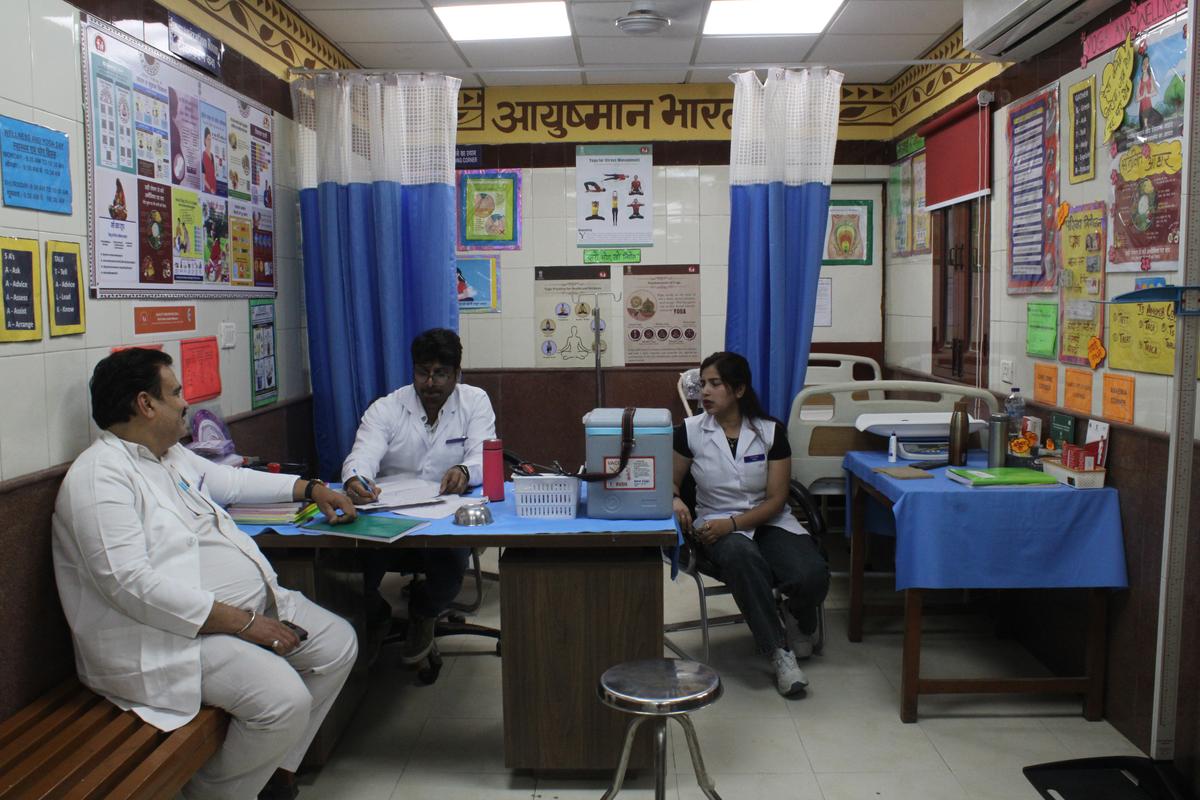Tucked inside the Tis Hazari courts complex, a yellow-painted health outpost, once a Mohalla Clinic, now wears new branding: Urban-Ayushman Arogya Mandir (U-AAM), announced through placards and signboards in Hindi and English.
When a group of lawyers walk in, curious about what has changed, doctors tell them that 14 diagnostic tests, previously outsourced, are now conducted in-house. Prenatal and postnatal care, family planning services, and biweekly yoga sessions (yet to begin) are also part of the expanded offering.
Upgraded care
Inside the main room, handmade posters designate specific areas — a first-aid management area, a wellness space, and a breastfeeding corner, which is placed behind curtains. Smaller rooms branch off into spaces for doctors, pharmacy, registration, diagnostics, and storage.
Of the two visitors, one has gastrointestinal issues and the other suffers from weakness. “I have been coming here for minor health issues like cold and cough for years. Now, more tests are conducted here than before,” says Anil Tomar, who practises in the chambers nearby.
The staff at the U-AAM, which offers free primary healthcare services, includes a doctor, a nurse, a multitask worker, and a sweeper-cum-guard. However, two doctors affiliated with the Delhi government are currently overseeing the clinic.
Footfall hovers around 70-80 patients daily, according to a doctor at the facility.
Quick diagnostics
U-AAMs are part of the Delhi government’s plan to improve the city’s health infrastructure. The government has promised to set up 1,139 such clinics in phases. While some of these are revamped Mohalla Clinics started by the previous Aam Aadmi Party government, many of the others are being newly built.
The doctor in charge explains that tests for haemoglobin, blood sugar, malaria, and dengue now happen on-site. “Reports here now get ready in 30 minutes, which was never seen before,” he says.
Another doctor, formerly at Lok Nayak Hospital, adds that most patients come for fever, joint pain, hypertension, and diabetes. “Earlier, people would queue for hours, losing their daily wages. Now, that will change.”

The staff on duty at a U-AAM include a doctor, a nurse, a multitask worker, and a sweeper-cum-guard.
| Photo Credit:
ANUSHKA KOGTA / INTERN
Being inside the court complex, the majority of early users are lawyers, guards, and shopkeepers. However, residents from nearby areas have also begun to visit.
Of the 93 diagnostic tests listed under U-AAM, 14, including cervical cancer screening, happen in-house. Seventy-nine other tests are outsourced. The nurse also handles the pharmacy and family planning, while a yoga instructor is expected to start sessions, twice a week, soon.
Low awareness
In Inderpuri’s F Block, another U-AAM quietly functions less than a kilometre from a still-operational Mohalla Clinic. But awareness remains low.
“I haven’t heard about the new clinic’s benefits. We still go to the old one,” says Vishal, a resident whose house is equidistant from both.
Sushma, another local, says she is fine with both the clinics. “I just want my medicines when I need them,” she says.
Meanwhile, former Mohalla Clinic employees, who are currently protesting their removal, say they have had no communication with the new U-AAM teams, who were recently posted at the facilities.
-Ammar Aziz Safwi
Published – June 09, 2025 01:37 am IST